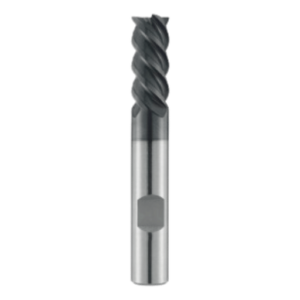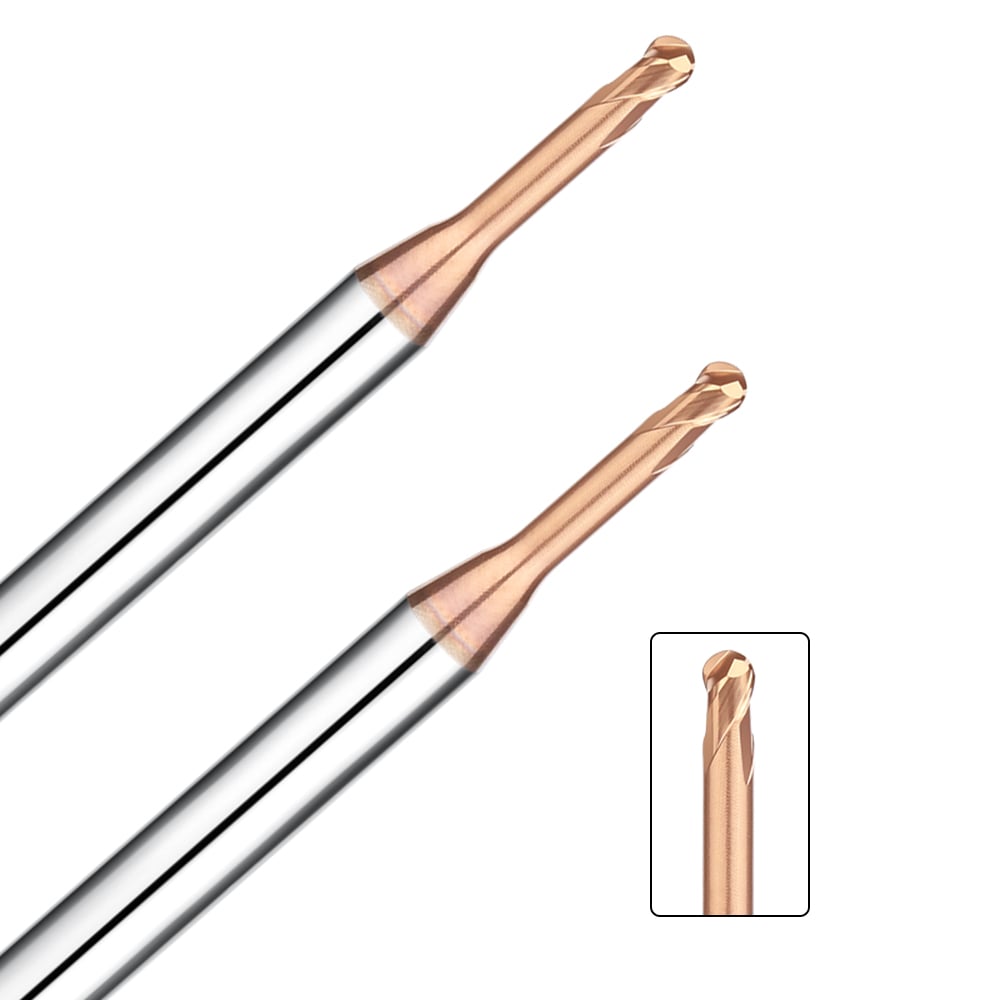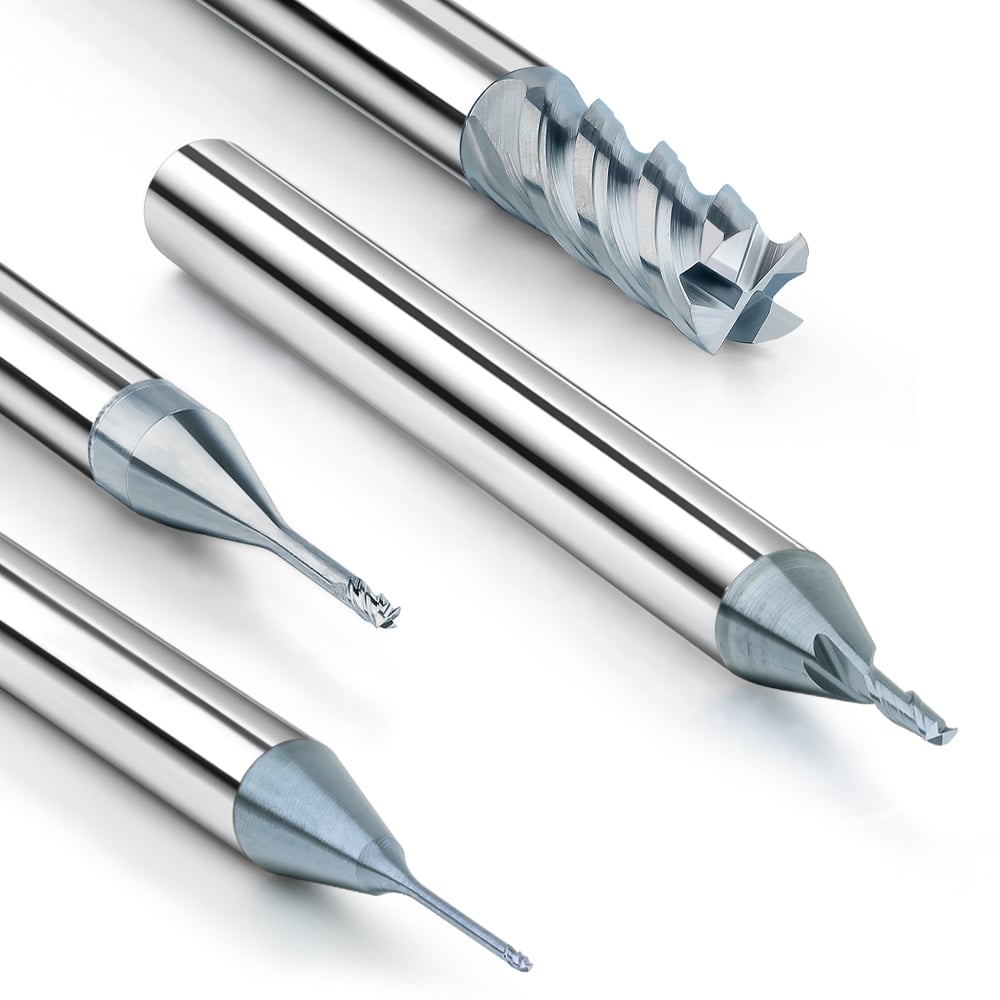In CNC machining, stainless steel is widely recognized as a difficult-to-machine material. Its high strength, work-hardening tendency, and poor thermal conductivity place greater demands on cutting tool selection and usage. Whether you’re working in mold making, precision component manufacturing, or the medical and food machinery industries, choosing the best end mill for stainless steel is directly tied to machining efficiency, surface quality, and tool life.
Many machinists—both beginners and seasoned professionals—often encounter similar challenges: What is the best milling cutter for stainless steel? What cutting geometry works best? Which coating offers optimal wear resistance and anti-adhesion performance? This guide addresses these questions by analyzing stainless steel’s properties and providing practical advice on tool selection, including geometry, material, and the best end mill coating for stainless steel.

Why Stainless Steel Requires Specialized Cutting Tools
Cutting Characteristics of Stainless Steel
Stainless steel is a tough material that presents multiple challenges during machining. These include:
-
Work Hardening: If cutting parameters are not properly controlled, the material hardens quickly. This can cause the tool to repeatedly cut on an already-hardened surface, increasing wear and cutting resistance—especially under low feed or intermittent cutting conditions.
-
Low Thermal Conductivity: Heat generated during cutting doesn’t dissipate easily. Instead, it builds up at the cutting zone and rake face, which can cause tool edge softening, annealing, and even microcracking.
-
Built-Up Edge (BUE): Stainless steel tends to stick to cutting tools, forming a BUE that distorts cutting geometry and leads to surface roughness and tool chipping.
Because of these challenges, standard end mills often fall short. Tool material, edge geometry, and coating selection become critical to maintain thermal stability and avoid adhesion during cutting.
Common Issues from Incorrect Tool Selection
Choosing the wrong end mill for stainless steel can lead to several serious consequences:
-
Shortened Tool Life: Without proper heat resistance or wear-resistant coatings, tools are prone to premature wear, chipping, and failure.
-
Poor Surface Quality: Inadequate tool geometry or flute count can lead to vibration, surface burning, or dimensional inaccuracy—especially during finish milling.
-
Low Productivity: Tools not optimized for stainless steel often require reduced speeds and feeds, limiting throughput and increasing cycle time.
To avoid these problems, always prioritize milling cutters specifically designed for stainless steel—tools that offer thermal resistance, efficient chip evacuation, and anti-sticking performance.

What Key Features Define the Best End Mill for Stainless Steel?
Tool Material: Carbide Is Preferred
Carbide end mills are the top choice for stainless steel due to their superior hot hardness, wear resistance, and cutting stability compared to high-speed steel (HSS). Specifically, ultra-fine-grain carbide with a high cobalt content resists stainless steel’s work hardening and adhesion tendencies.
So when you’re wondering what material is best for milling stainless steel, ultrafine carbide is your answer—especially for applications involving 304, 316, or duplex grades.
Optimal Flute Count and Cutting Geometry
Stainless steel produces long, continuous chips. Too many flutes or inadequate chip space can cause chip clogging and BUE formation. General recommendations:
-
2–3 Flutes: Ideal for slotting or side milling, offering superior chip evacuation.
-
4 Flutes: Better for high-precision face milling or cavity finishing, offering enhanced stability.
Geometry-wise, choose tools with:
-
High Helix Angles (40°–45°): Help reduce cutting forces, promote chip flow, and minimize heat buildup.
-
Large Rake Angles: Reduce tool pressure and improve sharpness, critical when cutting hardened or gummy stainless steels.
Tool Structure and Series Selection
-
Solid Carbide End Mills: Offer high rigidity and precision, ideal for uninterrupted cutting, thin-wall structures, and high-accuracy work.
-
Indexable Milling Cutters: Provide better economy for heavy roughing or batch production. Insert changes are faster and cost-effective.
Additional structural options:
-
Short Flute Length: For rigidity and vibration control.
-
Long Reach / Long Flute: For deep cavity or side-wall milling.
-
Bull Nose End Mills: Excellent for mold cavities, chamfering, and smooth transitions.
Match your cutter structure to your part geometry, machine tool rigidity, and required surface finish.

What Is the Best Milling Cutter for Stainless Steel?
Best Tool for Roughing Stainless Steel
During roughing, cutters face high cutting forces, heat, and hardened zones. Recommended features:
-
Chamfered Cutting Edges: Strengthen the tool edge and reduce chipping.
-
Thick Core Design: Increases rigidity and minimizes deflection under load.
-
Indexable End Mills: Offer durability and cost-effectiveness for rough passes, especially with reinforced inserts.
If you’re asking what end mill is best for roughing stainless steel, consider high-strength solid carbide or indexable cutters, paired with a high-pressure coolant system to enhance chip evacuation and control heat.
Best Tool for Finishing Stainless Steel
Finish milling demands tight tolerances and superior surface finish. Prioritize:
-
Bull Nose End Mills: Balance strength and surface quality for molds and curved surfaces.
-
Sharp Edges with Micro Rake Angles: Reduce cutting force and improve edge quality.
-
3 or 4-Flute, High-Helix Tools: Ideal for thin walls, small bores, or finishing contours.
For best results, use tools with sharp edges, heat-resistant coatings, and polished flutes to reduce friction and sticking—perfect for mirror surfaces or fine features.
What’s the Best Coating for Stainless Steel End Mills?
Stainless steel’s machining challenges require coatings that provide heat resistance, lubricity, and anti-adhesion. Selecting the best end mill coating for stainless steel can significantly extend tool life and improve surface finish.
Overview of Common Coatings
-
TiAlN (Titanium Aluminum Nitride): Excellent for high-temperature dry or semi-dry cutting. Ideal for general 304/316 work.
-
AlTiN (Aluminum Titanium Nitride): With a higher aluminum ratio, it forms a protective Al₂O₃ layer under heat, perfect for aggressive or hard stainless grades.
-
TiSiN (Titanium Silicon Nitride): Offers extreme hardness and wear resistance, great for high-speed finishing of mold-grade stainless steels.
-
nACo (Nano-Coating): Nanostructured coating with strong lubricity and thermal shock resistance, suitable for tough, sticky stainless types.
-
DLC (Diamond-Like Carbon): Ultra-low friction but moderate heat resistance; ideal for low-speed, precision finishing of medical or micro parts.
There’s no one-size-fits-all coating. Choose based on your machining strategy, workpiece grade, and coolant conditions.
Key Factors When Choosing Coatings
Consider the following:
-
Heat Resistance (800–1100°C): Prevents degradation during high-temp cutting.
-
Lubricity: Reduces friction and sticking, helping prevent BUE.
-
Anti-Adhesion: Especially critical for austenitic stainless steels.
-
Coating Adhesion Strength: Ensures coating durability during interrupted or low-feed cuts.
For most stainless applications, multi-layer nano coatings with high thermal resistance and low friction are the optimal choice.
Recommended Coating + Substrate Combinations
Pairing the right coating with the right substrate maximizes performance:
-
TiAlN + Ultrafine Carbide: Balanced toughness and wear resistance—ideal for general stainless steel machining.
-
AlTiN + Nano Carbide: High-speed, heavy-load cutting—perfect for molds or batch production.
-
nACo / TiSiN + Micro-Grain Carbide: Enhanced for difficult alloys (e.g., sulfur/nickel-bearing stainless).
-
DLC + Micro-Edge Tools: Best for ultra-fine surface finishing on medical or micro components. Combine with micro rake design for reduced cutting forces.

Actual Case Analysis: Performance of Different End Mills on Stainless Steel
When selecting an end mill for stainless steel, it’s often difficult to accurately assess a tool’s real-world performance based solely on technical specs or catalog descriptions. That’s why case-based analysis offers more valuable insights. The following comparison evaluates actual tool performance across three key dimensions: stainless steel material, tool design, and real-world machining parameters.
Differences in Tool Performance: 304 vs. 316 Stainless Steel
Although both are austenitic stainless steels, the milling behavior of 304 and 316 varies significantly:
-
304 Stainless Steel: Known for high chromium content and strong ductility, 304 is prone to severe work hardening during high-speed milling. This accelerates tool edge wear, especially in roughing operations.
-
316 Stainless Steel: With added molybdenum for enhanced corrosion and heat resistance, 316 is even more challenging to machine. Its higher cutting viscosity increases the likelihood of built-up edge formation and edge chipping.
Real-world testing shows that end mills with identical geometry and coatings typically have 15% to 25% shorter tool life when machining 316 compared to 304. Therefore, when asked “What end mill should I use for 304 stainless steel?” or “What’s the best tool for milling 316 stainless?”, the answer should consider anti-adhesion performance, heat dissipation, and cutting edge sharpness.

Practical Parameter Comparison: Spindle Speed, Feed Rate, and Cutting Depth
In stainless steel milling, parameter settings directly affect tool life and machining stability. Below is a comparison of three typical machining strategies under the same material condition (304 stainless steel):
| Machining Strategy | Spindle Speed (rpm) | Feed per Tooth (fz, mm/tooth) | Axial Depth of Cut (ap, mm) | Machining Feedback |
|---|---|---|---|---|
| Conservative | 3200 | 0.04 | 0.4 | High stability and slow tool wear, but low efficiency |
| Recommended | 4500 | 0.06 | 0.6 | Balanced efficiency and tool life; suitable for mass production |
| Aggressive | 6000 | 0.08 | 1.0 | Fast machining speed, but increased tool wear; requires high-performance cooling system |
Additional Notes:
-
Machining stability is positively correlated with spindle load fluctuations.
-
Under aggressive settings, if efficient cooling and high heat-resistant coatings (such as TiSiN) are not used, surface burning and premature tool failure may occur.
-
The recommended strategy provides a balanced approach to feed, speed, and thermal management, making it a reliable baseline for most stainless steel milling tasks.
These data offer practical insights for answering questions like “recommended parameters for stainless steel milling,” and help beginners develop a rational mindset when setting machining parameters.

Summary and Tool Selection Suggestions
When it comes to stainless steel—one of the most difficult materials to machine—choosing the right end mill for stainless steel is essential to achieving high machining efficiency and product quality. From material characteristics to tool structure and coating technology, every choice directly impacts tool life, cutting stability, and surface finish.
The following guidance draws on typical industry applications, logical selection strategies, and common misconceptions to provide CNC engineers and purchasing professionals with practical, scenario-based recommendations.
Tool Selection Recommendations for Specific Industries
Different industries demand different tool characteristics. Here are best-practice suggestions for common stainless steel applications:
-
Mold Manufacturing (e.g., 420/440 stainless steel)
Use high-rigidity, short-flute solid carbide end mills. Prioritize coatings like AlTiN or TiSiN, which perform well under sustained high temperatures and impact loads. -
Medical Device Manufacturing (e.g., 316L stainless steel)
Focus on surface finish and dimensional accuracy. Opt for a bull nose end mill with a micro-positive rake angle, paired with high-lubricity coatings like DLC. Use low feed rates and shallow cuts for stability. -
Food Equipment Industry (e.g., 304/316 stainless steel)
Balance batch efficiency and general-purpose usability. Choose 3- or 4-flute, high-helix end mills with TiAlN or nACo coatings, offering good chip evacuation and long tool life. -
Aerospace & Heat-Resistant Parts (e.g., 17-4PH, Inox series)
Select nano-alloy substrate tools with highly heat-resistant coatings such as TiSiN. Use conservative parameters to reduce thermal buildup during machining.
Matching tools across the matrix of industry + material + process goals helps reduce guesswork and avoid tool waste or machining failure.

Review: Five Key Dimensions for Selecting Tools
Throughout this guide, five recurring decision factors are emphasized when selecting a stainless steel milling cutter:
-
Tool Substrate
Choose ultra-fine grain carbide or nano-alloy substrates to improve chipping resistance and thermal stability. -
Geometry
Use high-helix and large rake angle designs to aid chip removal and cooling. For finishing, round-nose geometries are preferred. -
Flute Count
-
2–3 Flutes: Best for roughing; ensures chip evacuation.
-
3–4 Flutes: Better for finishing; improves surface quality.
-
-
Coating Technology
Match coatings to your operation (AlTiN, TiSiN, nACo, DLC) based on speed, coolant, and material hardness. -
Application Fit
Factor in material viscosity, part hardness, coolant supply, and machine tool rigidity to ensure stable performance.
Rather than chasing the “strongest” tool, always seek the best-fit solution based on multiple performance dimensions.
Common Misunderstandings and How to Avoid Them
Even with premium tools, machinists and buyers frequently make avoidable errors during tool selection or usage:
-
Myth #1: The more expensive the coating, the better
Premium coatings like TiSiN or DLC can underperform if mismatched with the substrate or operating conditions. Use coatings based on application needs—not prestige. -
Myth #2: More flutes mean better results
In stainless steel machining, too many flutes restrict chip flow and lead to clogging. Always select flute count based on cutting depth and feed rate. -
Myth #3: One tool, one parameter set
Each tool design and coating has a specific sweet spot. Blindly copying parameters across different tools can cause failure. Fine-tune based on testing and specs. -
Myth #4: Cooling doesn’t matter
Stainless steel generates intense localized heat. Without proper cooling or lubrication, even the best coatings will degrade. Prioritize internal coolant or MQL systems. -
Myth #5: Brand guarantees performance
Within the same brand, different tool series may vary drastically in design, material, and geometry. Always evaluate tools based on technical data and real-world performance—not just logos.

FAQ: Common Questions About Stainless Steel End Mills
Q1: Which End Mill Is Best for Deep Cavity Machining in Stainless Steel?
A: Deep cavity milling requires excellent chip evacuation and tool rigidity. Opt for a long-reach 3- or 4-flute end mill with a high helix angle (around 45°). This promotes chip ejection from narrow grooves and reduces thermal stress.
For coatings, choose AlTiN or TiSiN for heat resistance. When possible, use internal cooling or MQL to further enhance stability.
Recommended tools:
-
OSG AE-LNBD-H
-
SAMHO TOOL
Q2: What Should I Do If the Coating Peels Off During Machining?
A: Coating delamination usually results from excessive heat, tool overload, or poor coating/substrate compatibility.
Troubleshooting steps:
-
Check for aggressive cutting speeds or feeds.
-
Switch to a stainless-optimized tool (e.g., carbide + AlTiN/TiSiN).
-
Improve coolant strategy—avoid dry cutting or thermal shock.
-
Inspect tool edge condition—regrinding can reduce coating adhesion.
If chipping or breakage follows coating loss, it likely signals a mismatch between tool design and actual cutting conditions.
Q3: Why Is Tool Life So Inconsistent?
A: Unstable tool life often stems from systemic imbalances in machining conditions.
Common causes:
-
Using generic cutters lacking optimized edge strength or flute geometry.
-
Aggressive feeds/speeds beyond the tool’s intended range.
-
Poor workholding or spindle instability causing vibration.
-
Inappropriate coating selection or operating outside ideal temp/speed range.
Conduct a full system review—tool, machine, coolant, parameters, material—and perform wear analysis to diagnose.
Q4: Are There Any Cost-Effective End Mills for Stainless Steel?
A: Yes. The following are high-performance options with solid cost-effectiveness:
-
SAMHO SHTI Series (China): Nano-grade carbide with SH coating; ideal for mid-load 304/316 jobs.
-
YG-1 INOX-PRO Series (Korea): Optimized geometry for austenitic stainless; balances performance and price.
-
SANDVIK CoroMill Plura HMI: Premium durability for complex profiles and roughing—higher initial cost, excellent long-term ROI.
-
Kennametal KCPM15 Series: Strong edge reinforcement, suitable for stainless production lines.
Tip: Match tool choice to your machine’s rigidity, volume needs, and material grade. High cost-performance means value per part, not just low price.











